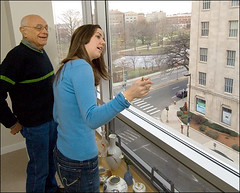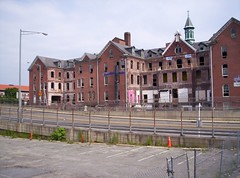Urban renewal revisited
 Douglas Healey for The New York Times. Bernie Rosen, 76, a retired teacher, and a neighbor, Lyndsay Stephenson, 24, in Mr. Rosen's apartment at Trumbull on the Park in downtown Hartford. Ms. Stephenson says she tells friends, "Come to Hartford. I swear, it's fun."
Douglas Healey for The New York Times. Bernie Rosen, 76, a retired teacher, and a neighbor, Lyndsay Stephenson, 24, in Mr. Rosen's apartment at Trumbull on the Park in downtown Hartford. Ms. Stephenson says she tells friends, "Come to Hartford. I swear, it's fun."This photo illustrates a phenomenon sometimes called "bookends" -- where the desire to live in the city is fueled by younger and older demographics. Both share a desire to not have to worry about housing maintenance, as well as the ability to partake of various art and cultural happenings, and to not be car-dependent. (Photo from the New York Times article "Downtown Hartford Stirs From Slumber"--online access for two more days.)
I first got a real glimmer of this exhibiting at the City Living Expo in DC a couple years ago. The H Street booth was one of the more popular of the neighborhood booths, and we talked to hundreds of people each day. Here's an excerpt from an "after-action" report I wrote about the experience:
THE QUESTIONS PEOPLE ASKED REALLY MADE ME CHANGE MY THINKING ABOUT TWO THINGS. I always write that "diversity of housing types" is important and necessary to the neighborhood, especially in terms of reducing displacement, but I didn't really know what that meant until we started getting questions on Saturday...
First, people of all ages kept asking about condominiums. I explained that this is coming but we are working on some zoning changes to make this happen. We need to work with the property owners on the 200 and 300 blocks of H Street to make sure this happens. It should also shape the development of the BP site. The land that we have available is too precious to waste. And as everyone knows we need more residents to strengthen the neighborhood ane more customers for the commercial district.
Second, it means that over the long term we (HSMS) really need to work on some of these broader housing issues as they relate to revitalization of the greater neighborhood and the strengthening of the H Street retail trade area.
We need to develop a position statement on housing issues in the broader neighborhood. We need to monitor developments that are in our trade area, developments that we might not ordinarily monitor, because they are in Wards 5 or 7. This should be linked to the encouragement of transit-oriented development associated with the proposed light rail developments along H Street/Benning Road and Florida Avenue.
(We probably need to develop a position statement about light rail as well. Personally I think it should be encouraged, and on an accelerated timetable. The paper on the www.apta.com website called "Bring Back the Streetcars" indicates that a 4-6 year timetable is not out of the question. It makes sense to coordinate this with the streetscape improvement program. Fixed-rail transit investments generate great economic returns. It will vastly benefit the H Street commercial district. It should be no surprise that the H Street commercial district began declining once streetcars were removed from the corridor...)
 Condominiums in the old DC Children's Museum building are selling for $600/square foot and apparently are more than 50% sold, according to an ad I saw in the Post for the companion project of new buildings on the same block.
Condominiums in the old DC Children's Museum building are selling for $600/square foot and apparently are more than 50% sold, according to an ad I saw in the Post for the companion project of new buildings on the same block.
It means that we need to weigh in on projects such as the Clark Realty development on Bladensburg on the old Sears site. Maybe they need more density. It means we need to advocate for housing above Hechinger Mall (like Kevin and I have been saying for years.) It means we need to look at the northern parking lots of RFK (problematic because they are owned by the federal government? which are wasted. Condominiums could be developed here, along with maintaining quality public space so that the Open Air Farmers Market would not be displaced. Etc.
 Mass Court Apartments (Pritzker interests). Photo by Dan Malouff.
Mass Court Apartments (Pritzker interests). Photo by Dan Malouff.
We also need to work on inclusionary zoning and related incentives to ensure that affordable housing is required, as well as to ensure quality design. (WRT design, don't think it doesn't matter. The Pritzker condominums at 300 Mass Ave. NW are much more attractive than the condos at 4th and Massachusetts by Paradigm, and that is because the latter development used office building style window glass instead of the residential style windows of the former. Similarly, the new apartment building on the 1000 block of New Jersey Avenue NW is pretty utilitarian. Incentives should have been provided to get them to include balconies and other design features that would have softened the facade and made the building look more inviting.)
(Note that the newest housing in the greater neighborhood -- 800 block of 10th St., Wylie Court, and the development across from Hechinger Mall -- is all pretty utilitarian and cheap looking and really denigrates the overall aesthetic of the neighborhood's architectural style and sense of place.)
 The Pentacle Apartments across from Hechinger Mall were built in the urban renewal era--and it shows.
The Pentacle Apartments across from Hechinger Mall were built in the urban renewal era--and it shows.



0 Comments:
Post a Comment
<< Home